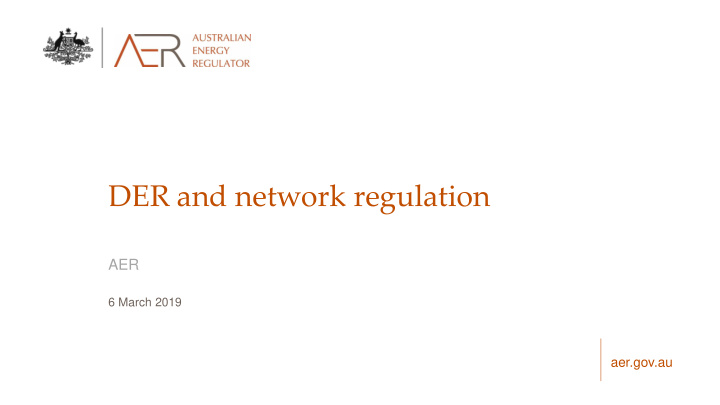



DER and network regulation AER 6 March 2019 aer.gov.au
Our presentation • Overall thoughts • Our experience of the energy transformation • What does that mean for incentives? • What have we been doing to promote efficient expenditure • Totex pros and cons aer.gov.au 2
Overall thoughts • Efficient integration of DER into network regulation creates a range of opportunities and challenges, importantly noting that these challenges and the opportunities won’t necessarily be uniform between regions aer.gov.au 3
Our experience of the energy transformation • DER penetration has been under way for a number of years. To date, it has not been a big driver of capex. aer.gov.au 4
Our experience of the energy transformation • Capex proposals coming to us now show an increasing focus on responding to solar-PV penetration: monitoring and addressing constraints • There are potentially major demand drivers on the horizon (e.g. electric vehicles) • There are related potential developments for managing supply and demand fluctuations (batteries, pumped storage, synchronous condensers etc) aer.gov.au 5
Our experience of the energy transformation • There are also a range of different directions that the overall management of DER could take • eg passive DER vs active DER • The rate of change of technology also heightens the risk of asset stranding- timing and value of investment is critical aer.gov.au 6
Overview of DER impacts on network regulation System issues Localised network issues ● Whole of system security issues ● Power quality issues (frequency/voltage) ● Localised network capacity Efficiency Future role of DER DER ● Fringe of the grid ● Provision of energy services ● Network expenditure ● Distributed service operator assessments Consumer issues ● Equity New energy market ● Reduced customer base for competition energy networks? aer.gov.au 7
What does this mean for incentives? • Greater range of options beyond traditional network-solutions; contestability and capex incentive issues • There are conceptual and anecdotal arguments to support a conclusion of capex bias but it is very difficult to test empirically aer.gov.au 8
Work we have been doing to promote efficient incentives • Establishment of CESS and DMIS • Binding rate of return instrument • Changes to RITs to better accommodate non-network alternatives • Tariff round-tables, TSSs • Participation in steering groups (eg DEIP) aer.gov.au 9
Could totex help? • Potentially. The pros and cons depend on what type of totex model you are considering, but in general: – It can mitigate against financial drivers of capex bias; – It diminishes the materiality of differences in capitalization policies aer.gov.au 10
Implications to be aware of • Disconnects revenue from capital funding and depreciation from the economic usefulness of the assets. Could have long term implications. • Material price impacts from the choice of ‘slow - money’ proportion, which is by nature somewhat arbitrary aer.gov.au 11
Overall • The energy transformation heightens the importance of a framework that can accommodate flexibility in expenditure assessment and incentive mechanisms. • We support a network regulatory framework which allows the flexibility for evolution in: – Assessment – Incentives – Consumer engagement in those assessment processes aer.gov.au 12
Recommend
More recommend